Nottingham Area Bus Photos
Nottingham Area Bus Photos
I have just spent some time trundling through some memory-inducing pics on your website that include these vehicles.
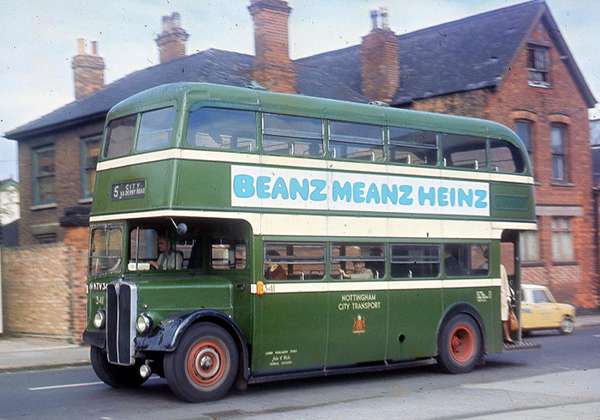
Here is Nottingham City Transport Roberts bodies Regent III during the twilight of its life, in 1966 speeding towards Beeston Square on the 5A/5 circuit.
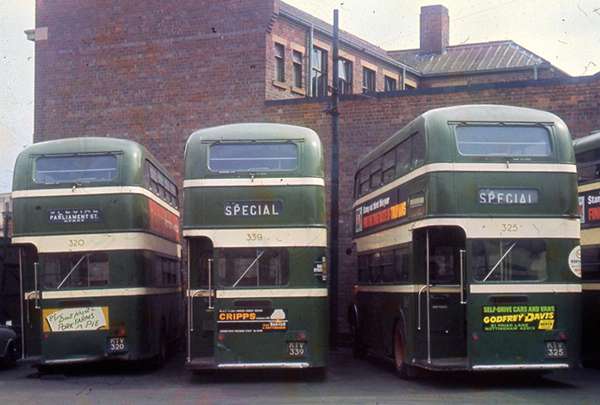
My second picture disproves the "back of a bus" suggestion of ugliness - NO WAY!!
Despite the period style rain deflectors and winding windows these buses
were I think timelessly handsome and surely their good looks and solid
construction contributed to their long lives, e.g. compared to their
contemporary but rather elderly-looking MCW bodied sisters. Or perhaps it was
their 8 foot-wide bigness, like how NCT's 8 foot wide trolleybuses outlasted
the 7'6 ones. Note how there is NO bulge above the radiator area like on
Sheffield ones - NCT's were totally FLAT-fronted.
Many of these vehicles were, I consider disfigured by being repainted
into the post-1962 simplified livery (more cream) but those ones got withdrawn
among the earlier batches and all the later survivors were in the traditional
colour scheme. In that respect, it was noticeable that late period overhauls
did not get a full repaint, just the area below the lower deck windows, and
these were also identifiable, like this example, by being given the fleet name
transfers in two lines within one bay, instead of being a single line spread
across three.
I recall also, around this time, that another of the last survivors, No
340 had a distinctive and different exhaust note, prompting some commentators
to suggest it had been fitted with a Gardner engine. I don't know about that,
really, but it did also apply to at least one the later Regents of the OTV
sequence - perhaps someone out there knows something?
Rob Hancock
12/03/13 - 06:38
Thanks Rob. You have made my day with these additional pictures. Now - does anyone by any chance have interior pictures. That would be the final icing on the cake!
Stephen Ford
12/03/13 - 06:39
Rob, I notice that the regents in these photos have round mirrors on the near
side. Would these be the same on the cab side?
I will have to try and get some for 161, a shame as I have just
fitted new square mirrors, but I think the round ones look better.
The three together in the photo look really great and I certainly
agree with your comments.
I imagine the Beeston route was one of the best for keeping the
batteries charged up with the long, straight runs to get a bit of speed
up and put some current into the old set of four, six volt
batteries.
David Morris
12/03/13 - 06:41
Back in May 2012 I proposed the question if anyone knew where the split
between the Roberts bodied Regents with two opening windows per side on
the lower deck and four opening windows per side upstairs ('type a') and
those with three opening windows per deck per side ('type b') occurred.
Thanks to help from Bob Gell I can now say that 'type a' vehicles were
301 to 323 and 336, and 'type b' vehicles were 323 to 335 and 337 to
341. Bus 336 was delivered out of sequence, hence, presumably, its
adherence to the 'type a' window layout. A lasting childhood memory is
that of Roberts bodied Regents standing on Hanley Street (the city
terminus of services 1,7 and 22) with wooden chocks under the offside
front wheel.
The chocks were fastened to a chain that was secured in the cab.
Such chocks were standard fittings on NCT's post war bus and trolleybus
deliveries. The Hanley Street services were operated by Bulwell Depot
with buses 301 to 324. These buses remained at Bulwell until 1964 when
they were replaced by Fleetlines 79 to 94 (the frequency of these
services being reduced with the introduction of 'high capacity buses',
hence fewer buses were required).
The last two Roberts bodied Regents in service were 340/341, which
were withdrawn at the end of December 1966. Its interesting to see that
341 had lost its side destination blind, with the glass being painted
over, by the time it was photo'd in Beeston on the 5/5A. From memory
side destination blinds on buses started to be removed about 1962/63
with the glasses being painted over, either cream or green depending on
the livery style and/or side destination location (the Regent Fives and
PD2s had the side destination in the cant rail above the rear most lower
deck windows). Trolleybuses retained their side destination blinds until
their demise.
340 certainly didn't have a Gardner engine. It may have a non
standard exhaust system that accounted for its 'throaty' exhaust note
and this may have been the case with some OTV Regents.
Michael Elliott
13/03/13 - 06:46
Rob. What superb shots of superb vehicles!
Yes, the OTV Regents had round mirrors on the cab side. I also
remember 340's exhaust note, rivalling the Regent Vs. Such a shame that
XTO 266 is no longer active in preservation. The outline of these
Roberts bodies always remind me of the Routemaster, especially with the
four bay construction - anyone agree??
Bob Gell
13/03/13 - 08:09
Somebody's has been keeping it secret that these formed the basis of the Matchbox model that preceded the Routemaster. Always considered an RT it didn't look remotely like one but it did look very much like one of these Roberts-bodied Regents. And the view above is even on the 5, which was the model number and what was cast where the destination would be.
David Beilby
13/03/13 - 08:55
At the risk of going into boring old f**t mode again: Balance and Integrity of design. 8' wide and with other subtle differences, I think the Nottingham Roberts work and look good in a way that the 7'6" Sheffields don't. From the many posts on this forum, the quality of the Roberts was never in doubt but the "speeding" Roberts on the 5/5A looks both good and attractive.
David Oldfield
13/03/13 - 16:48
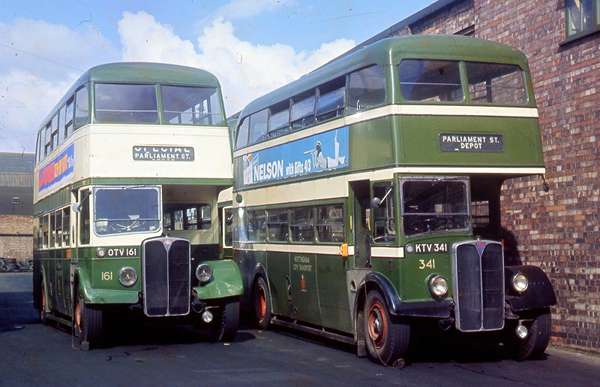
Here is 341 again, in Manvers Street yard alongside now-preserved OTV 161,
obviously before its Hull career.
Picking up on comments by others - note that both buses have ROUND
mirrors both sides, and both are seen using the block-on-a-chain that
was famously associated with the steeply downhill Hanley Street terminus
of the 1, 7, 22 routes.
Rob Hancock
14/03/13 - 07:07
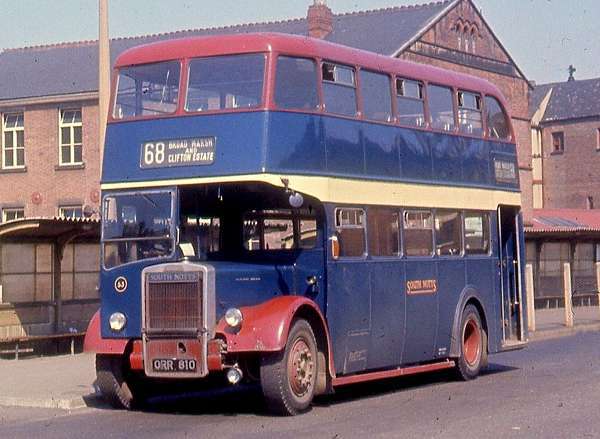
Here is a South Notts PD2, this time one of the earlier batch acquired for
the Clifton services in the early 50s.
Seen here at Broad Marsh in the mid-60s, 53 had recently been
fully repainted, and looks particularly smart.
Up until this repaint, 53 had been the last wearer of the previous
style of livery for this type, which included cream for the whole of the
lower deck window surrounds, and had been getting particularly tatty.
Doesn't she look good?
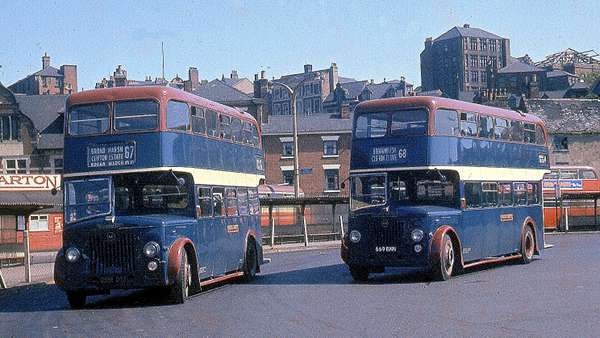
Here is a mid-60s view at Nottingham Broad Marsh of a pair of Weymann Aurora
bodied South Notts Leylands,
PD2 on the left. PD3 on the right - spot the difference??
The rearmost bay gives the clues - the size of the side and back
upper deck windows, only v-e-r-y subtle other differences were apparent.
We locals knew the fleet numbers and registration numbers of
course!!
Rob Hancock
16/03/13 - 09:15
I only recently discovered this website, submitted a few pics and was
pleasantly surprised by the reaction, in particular of my pic of the
speeding Roberts-bodied Regent III at Beeston. Thank You.
Anyway, I have a couple of other "speeding" shots, both taken on the
last Saturday of crew operation on the Arnold routes.
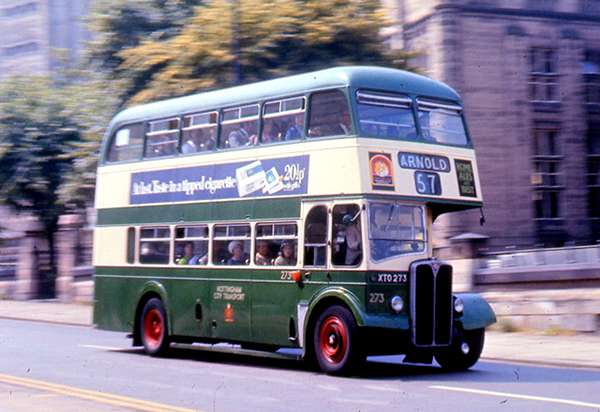
The first one is of the last of the breed, 273 passing the old Central
Library building in South Sherwood Street.
This bus had a number of distinguishing features, like different style
opening windows (replaced by this time) and big, triangular flashing
indicators.
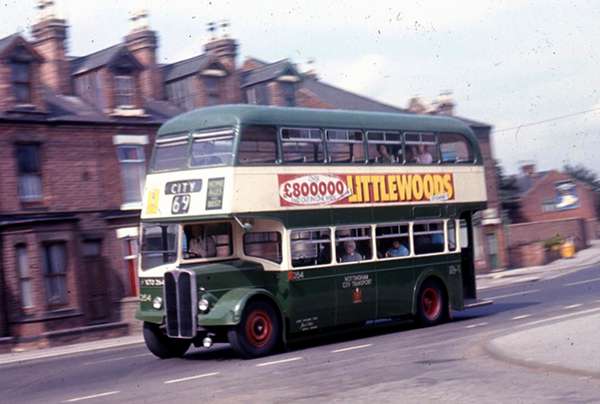
The other shot is approaching Daybrook, Mansfield Road heading towards town
the same day.
This was a super day, weather-wise and I was out and about on my
push-bike and bagged some precious memory shots.
Why did I not go out and about before of course?
Anyroad up, from my bus-watcher viewpoint, these were magnificent
machines, and produced breath-taking sound effects to match their
sparkling performance, so glad I am old enough to have had the "I was
there" experience.
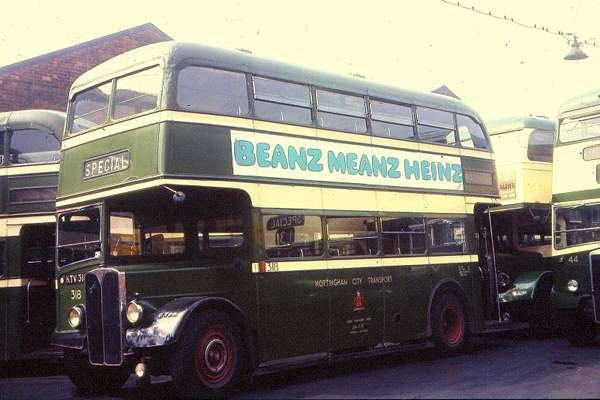
Here is another shot of a Roberts bodied Regent III the boringly standard 3/4 view of 318 in Manvers Street yard, but despite being a bit bashed-about around the front nearside pillar, isn't she lovely??
Rob Hancock
18/03/13 - 08:09
Hello, me again, thanks for the encouragement, got me rummaging again! Switching the subject matter to AEC Renowns, here are one example from Nottm City Transport, and BOTH of the West Bridgford pair.
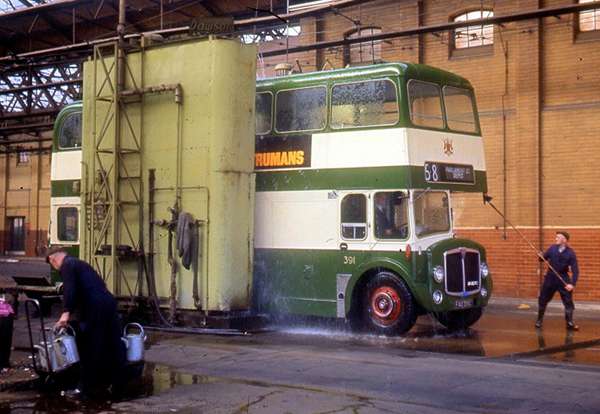
The first pic is of NCT 391 having a quick bath, nearly new, since it still has the white plastic AEC letters on the grille - these disappeared quite soon. This is one of the only seven Northern Counties bodied examples more handsome than their Weymann sisters and something about them that harks back to the popular Roberts bodied Regent 3s don't you think?
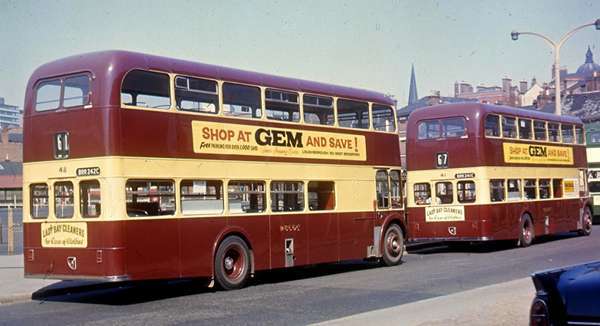
In contrast to the NCT full-height examples, here are the two West Bridgford
low-height East Lancs bodied ones.
Another flat-fronted style, with the two rows of seats upstairs in front
of the stairwell, but again, handsome machines.
I lived at Clifton until the mid-sixties, and for my journey to work in
Nottm, I sought out bus journeys that seemed to be diagrammed for
interesting vehicles, like a South Notts Duple Roadmaster - an unusual
choice of single decker for a peak time trip. Later, spring 1965 I was
traveling on the last of the pre-war AECs, rebuilt from highbridge to
lowbridge for the Clifton routes in 1952 (No4?).
Anyway, the last time I did that journey, 1st March 1965, instead of the
old-timer turning up, I was offered my first sight, let alone ride on
the first of the new Renowns.
And I was hooked!
Rob Hancock
20/03/13 - 06:37
The only other bus I remember with triangular flashers as fitted to 273 was
trolleybus 506.
If there were others there weren't many of them.
Like you I lived at Clifton in the 1960s, although I was still at school
when the West Bridgford Renowns arrived. I recall that West Bridgford
number 4 often worked a 61A journey that was on Farnborough Road heading
towards Fairham School around eight forty in the morning. The first time
I saw a Bridgford Renown it was on this working. Number 4 was the last
of three converts to lowbridge layout. Numbers 8 and 9 (CRR 91 and CRR
92) were converted ready for the inauguration of the Clifton services in
October 1952. Numbers 8 and 9 were withdrawn from service in 1957 and
were sold for further service, 8 to Roy's Motors and 9 to Makemson's).
Number 4 (FNN 104) was converted in March 1953 and was sold to
Nottingham showman James Mellors and subsequently scrapped. Do you
remember number 4's blue lacquered bulkhead window behind the driver's
cab?
Michael Elliott
20/03/13 - 08:21
Hi Rob, what camera were you using when you took the shots of the speeding 243 and 264 Regents? Ho! another question if I may, was it photograph or slide film?
Trevor Knowles
22/03/13 - 09:12
My camera - at that time I remember I was borrowing my dad's camera for
colour pics. I cannot for the life of me recall what make it was, just
that it was some cheapo thing he got from Dixons, and by this time I
could only get it to work by holding it upside-down!
The shutter jammed if you tried it the right way up!
Also at that time I was using Ektachrome-X slide film and a postal
processing company at Hatton Garden.
My black-and-whites (which you will eventually see on my trolleybus
gallery) was an elderly Mamiya using roll-film. A not very sophisticated
camera, I had many rubbish results, and thankfully I can now salvage
some previously hopeless cases, thanks to Picasa, to generate some
just-about passable shots.
If only we had todays digital equipment then????
Rob Hancock
22/03/13 - 17:07
I recall that Dixon's own-brand products were called 'Prinz' (I had one of
their cameras) and Curry's radio products originally 'Triumph' and later
'Saisho'.
I bought a bargain Triumph VHS recorder with cable remote when Dixon's
took over Currys. My first 35mm camera was an Halina! It all seem so
dated now!
Chris Hebbron
23/03/13 - 16:12
Rob
Your 'cheapo camera' would almost certainly have had a single shutter
speed setting, typically 1/30th or 1/50th second, so you did remarkably
well to pan the camera accurately enough to freeze the buses as well as
you have. The dynamics of movement are beautifully captured even though
some of the detail is blurred
Alan Murray-Rust
25/03/13 - 17:00
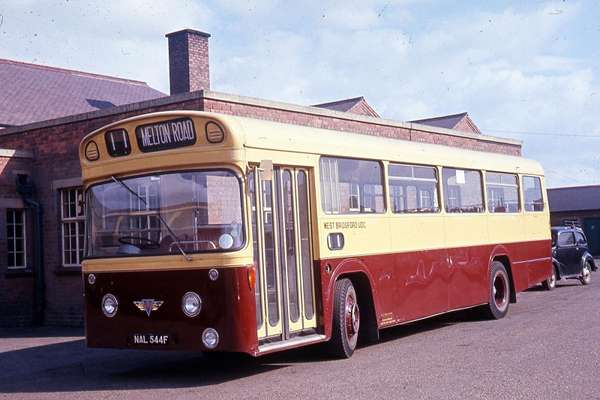
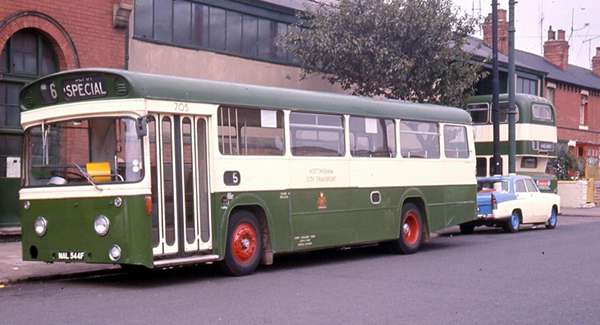
These views are both of the same vehicle, one of the AEC Swift AH505s with
East Lancs body, new in 1968.
The first view is at the WBUDC depot in Abbey Road, when quite new,
showing the traditional West Bridgford colour scheme but with more
modern branding (only ever seen on this bus and its sisters), and the
second view is after the NCT takeover, repaint, and loss of the red
triangle the photo was taken in Piccadilly, alongside the erstwhile
Bulwell depot.
I think WBUDC acquired these with a view to driver-only working on
lightly loaded trips, but that never got off the ground and these nice
buses had a short life, being offloaded by NCT in 1975/6.
Rob Hancock
26/03/13 - 07:20
West Bridgford UDC made several attempts to introduce OMO on some of the workings on the 11/12/14/24 group of services. At one stage a Chesterfield AEC Reliance was hired and operated on these services, but crew operated as agreement could not be reached with the trade union on the introduction of OMO. In the end West Bridgford, due to continuing financial losses,gave up and sold the Undertaking. Barton and NCT were both in the running for purchasing it, but NCT could offer continuing membership of the Local Government Pension Scheme and NCT conditions of service to the WBUDC staff and this was the deciding factor leading to NCT's acquisition of the Undertaking. West Bridgford considered the joint operation agreement with NCT to be biased in NCT's favour as the arrangement was for a 50/50 split of mileage. In actuality more than 50% of the mileage was in the West Bridgford area (because any extension to the joint services was at the West Bridgford end) but NCT could not be persuaded to amend the agreement, which dated back to 1928 when joint operation first started. The joint operation agreement with NCT in respect of the Clifton services had lapsed when NCT diverted its Clifton services via Clifton Bridge in March 1958.
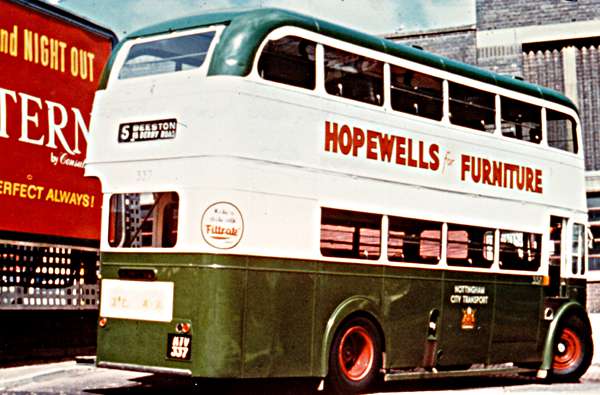
Maybe not everyones' choice of livery but still, to my mind, part of the Roberts' bodied Regent story. This shows 337 (a photo from my collection but the copyright holder is unknown) when repainted in the first style of the new livery in 1962. Only a couple of buses were painted in this style before the green band around the cantrail was introduced. Bus 337 is parked up at Granby Street before setting off to Beeston on service 5 via Derby Road. The 5A also departed from Granby Street but via Castle Boulevard to Beeston. The 5/5A operated as a circular service i.e. out as a 5 and back as a 5A with the 5A returning as a 5. Rob Hancock's recent posting shows 341 in Beeston. Services 4/4A to Beeston departed from the Old Market Square to Imperial Road at Beeston with the 4 via Derby Road and the 4A via Castle Boulevard. Roberts' Regents could also be seen on the 4/4A.
Michael Elliott
26/03/13 - 16:20
Thanks for that, Michael, you have reinforced my view that this plainer
livery did not flatter these buses, but they remained good looking even
from the back!
The later addition of a central green band was a slight improvement, and
the upper rear emergency exit surround also got some green. What I
cannot now recall - did they also get all the rest of the upper deck
window surrounds painted green?
Rob Hancock
28/03/13 - 06:54
Rob,
I'm only aware of two Roberts Regents being repainted into the new
livery style. These were 317 and 337, of which 317 had a green cantrail
and the emergency exit in green, but the upper deck window surrounds
were cream.The style used on 337 was also used on a PD2 - number 21 - a
photo of which was in the 21/4/62 edition of the Nottingham Evening
News. The first report on the new style livery was in the Nottingham
Evening Post on 27/3/62 (I remember seeing 21 in the new livery during
the school holidays at Easter 1962). Number 21 was certainly repainted
with the upper deck window surrounds in green and a green cantrail but I
don't know for certain about 337. It's possible that 337 received a
green cantrail and a green emergency exit prior to its withdrawal in
1965. The livery style with green cantrail and emergency exit but cream
upper deck window surrounds was used for repaints on a number of low
numbered OTVs and some PD2s and on the NAU Fleetlines when new. The
livery style with green upper deck window surrounds and green cantrail
was introduced for repaints during 1963, the first new buses in this
style being the RTO Fleetlines, and was in vogue for a number of years
before being superceded by the livery style with two narrow green bands
around the cantrail.
Michael Elliott
29/03/13 - 07:30
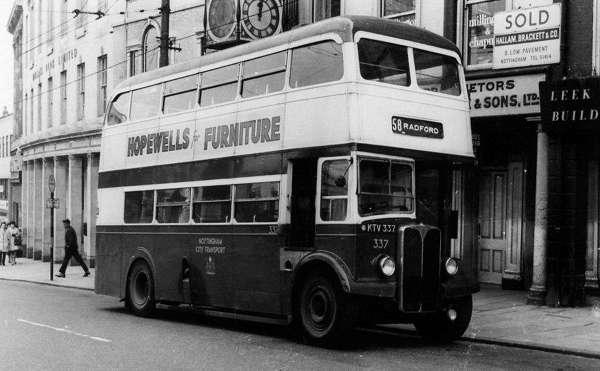
To amplify Michael's reply to Rob Hancock - from my schoolboy records of the
time, there were five buses painted in the original version of the new
livery in April/May 1962: 21, 25, 30 (ATO), PD2/Metro Cammell; 144
(OTV144) AEC Rt III/Park Royal and 337 (KTV337).
All were amended to the revised version as shown in the attached photo
(copyright unknown) by August 1962.
Subsequent repaints from May 1962 to around June 1963 were in this
version of the livery;
Those I have recorded (not guaranteed 100% complete) are:
PD2/Metro Cammell:
2,3,4,8,10,11,12,13,15,16,17,18,19,20,21,22,23,25,27,28,29,30,32.
AEC Rt III/Park Royal: 127-142 inc,144/5/9,152/4/7,171.
AEC Rt V/Park Royal: 209,212/4/7/9,222/5/8,231,240/1,258,267.
AEC Rt III/Roberts: 309,312/4/6/7,321/9,337/8.
Daimler Fleetline/Park Royal 46-63 were all delivered in this revised
livery in October to December 1962.
Within a few months, 62 was amended by having the upper deck window
pillars painted green.
Around the same time, 63 was repainted with green lower and upper deck
panels, with cream window
surrounds up and down and roof (ie Trent style layout).
As Michael states, the version as tried on 62 was then adopted as
standard fleet livery for a number of years.
Bob Gell
30/03/13 - 07:45
Interesting responses to stirring up memories about which/what versions of
the new livery were applied to the Roberts bodied Regent IIIs. As I said
elsewhere, I lived at Clifton early 50s to mid-60s and I do recall my
first sighting there of PD2 21 in the first version of the new livery. I
did not like it, although I accepted that it was inevitable since the
rationale was described as facilitating spray-painting, and if any of
the fleet could carry it off, then these PD2s were the ones that could.
The subsequent additions of a bit more green were slight improvements
but I just could not accept this style when applied to my beloved
"flat-fronted ones" as I knew them. As the only members of the immense
"KTV family" to be so afflicted, I took some comfort in realising that
they must have had some official expectation of a reasonable
future.
I do remember the experiments with Fleetlines 62 & 63 of variations in
possible future liveries, and that Pendred Hairdressing featured
heavily. What became of them?
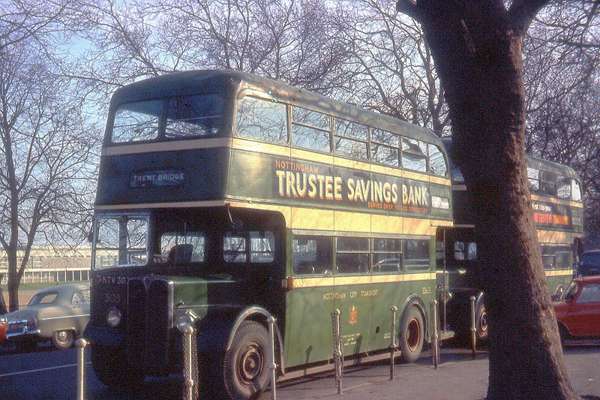
"Going Back" to how things used to be - here are a couple more in the
traditional style while laying over on Victoria Embankment between
duties on football special trips in the mid-60s.
I read in some book many years ago that the traditional style Weymann
bodywork exactly suited the ambiance and general personality of the
Regent III. I would not disagree with that, but would say the Roberts
version as used by NCT was an equal match.
Please agree?
Rob Hancock
30/03/13 - 10:10
Although, Rob, I heard it said - especially regarding the Sheffield Roberts Regents - that Roberts wanted to emulate the elegant lines of the Weymann four bay design. Interestingly enough, if you can remove (in your mind's eye) the main body of the NCB deckker and just retain the front and rear domes, there is more than a little of Weymann in them, particularly the front one. [Back to imitation being the sincerest form of flattery?]
David Oldfield
03/04/13 - 08:04
The original object of the change of livery style adopted by NCT in 1962 may have been to facilitate spray painting but NCT buses continued to be brush painted for many years after 1962 - well into the era of Volvo Citybuses etc.
Michael Elliott
04/04/13 - 07:00
A couple more Nottingham area shots from my camera days in the late 60s:

The first one is in that special place for bus pics at that time - Nottingham Cattle Market, where vehicles were parked while working football specials. There is a pre-menstrual Daimler on the right, but more interestingly, one of the iconic MGO Regent 3s (look at the state of the front of the chassis) and one of the rebodied Guy utilities, both having worked specials for Forest supporters from Erewash Valley locations.
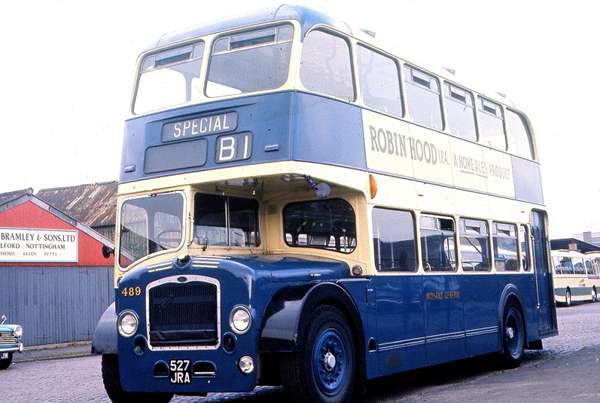
Second is at the same location, a typical MGO Lodekka in sparkling condition. Doesn't this livery look so good, with no extraneous beading, so clean, so smart?
Rob Hancock
05/04/13 - 05:53
I consider the MGO Regent 3/Weymanns to be a classic bus. Pity that the attempted preservation of MRB 40 failed. Notts and Derby had several such buses transferred from Mansfield and District (trolleybus replacements) one of which was rebodied with an ECW body after an accident (presumably the ECW body was intended for a Guy Arab).
Michael Elliott
08/04/13 - 09:00
Please allow me to trickle out a couple more of my 60s shots:
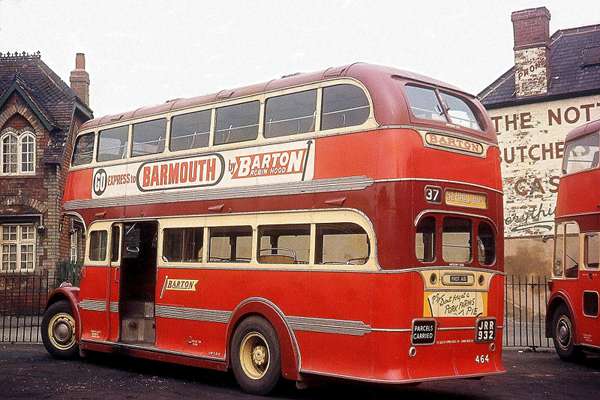
First up, self-explanatory, if any Nottingham area vehicles were iconic, then these were up there at the top of the list - the Barton PD1s with beautifully styled Duple bodies. Just let your eyes caress those curves, eh? This was on a Sunday morning tucked away at Huntingdon Street bus station, a happy hunting ground for me and my (dad's) camera in the mid/late 60s.
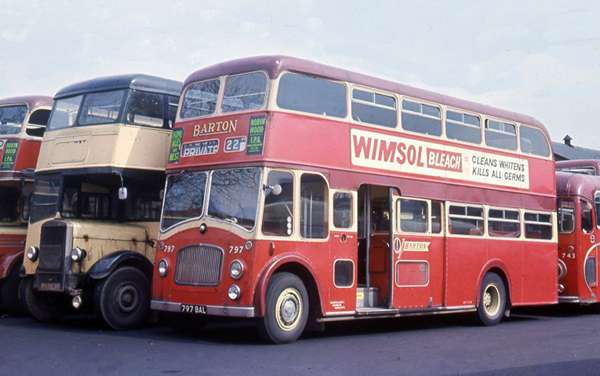
Second up, more vehicles parked up for their Sunday rest day: front of stage, one of the rebuilds, but the yellow and black thing behind is of more interest. RN 8639 is ex-Ribble, (you can discern the conversion of the previous square triangle destination aperture) a TD5 with Leyland-style Alexander body, more recently with South Notts, but by now with Baldwin and Barlow, contractor of Bunny, Notts. I remember this bus arriving with South Notts and being surprised by its choice as their No 72. 69 & 70 had been new Weymann Aurora PD3s, modern and effective machines, 71 was a very young second-hand PD2 with Northern Counties body. 71 was a handsome vehicle and a lively performer, I wonder if it was the inspiration for South Notts to home in on Northern Counties for so many future new purchases? Anyway, returning to 72 – perhaps the modern-ish bodywork was the attraction, but its performance was distinctly "old" sounded old, made heavy weather of acceleration and heaving itself up gradients. By contrast 73 onwards were more second-hand purchases, but this time a batch of more lively PD2s with Brush bodywork (also ex-Ribble) which got reintroduced to the area of their birth in that the South Notts main drag went past the Brush works on the approach to Loughborough. Before acquiring "72" Baldwin and Barlow had used an earlier ex-South Notts bus, I think it was 60, (JNU 463?) one of the ex-Chesterfield TD5c, very characterful buses, especially in the sound department, but almost silent when at speed. In the early 70s, I commuted from Nottingham to Loughborough, using South Notts of course and picking up on previous comments by others, their fares were irresistible, then 25p for a day return. Whenever Nottingham City Transport put up their fares on the Clifton routes, South Notts had to up their fares to as not to undercut NCT, and by this time, the South Notts fares to as far out as East Leake had to rise to stay above NCTs to Clifton. Apart from the attractive fares, South Notts had interesting vehicles, their services were reliable and their staff were nice people, so glad to have experienced this operator at this special time.
Rob Hancock
09/04/13 - 14:04
I do like the Duple Titan, the door hardly looks big enough to fill the gap and strange it slid front to rear as apposed to the usual rear to front. Or was there two sliding doors meeting in the middle like some lift doors, I can't see one in the shot. I beleive the brief description you gave to the other Barton bus in the second shot as 'one of the rebuilds' were rebuilt Tigers not Titans not sure of the date new for the chassis but the rebuild was in 1958
Trevor Knowles
09/04/13 - 16:47
Trevor, you have surmised correctly - the Duple PD1s had two sliding doors that met in the middle (bi-parting to use the posh phrase!) There were a number of earlier pre-war vehicles with similar bodies, some new and some re-bodied second hand. These were supplied by Duple and Willowbrook, and all had one-piece doors which closed in the normal way to the front. From photos it appears that the Duple ones all had internally-mounted doors, whereas the Willowbrook version had them externally-mounted. Doors on the 1948 Duples were power operated, but I think the earlier ones were manually heaved!
Stephen Ford
10/04/13 - 06:44
During the 1950s the Barton PD1/Duples were rebuilt by Barton owing to rot in
the wooden body frames. At first the rebuilds faithfully followed the
original Duple specification but as the rebuilds continued economies
were made. At first this manifested itself in the rubber mounting of the
Barton 'glazed' name plates at the front and rear of the bodies and then
on the last rebuilds the substitution of Barton transfers for the glazed
name plates.
South Notts' switch to Northern Counties for its body orders may have be
influenced by the acquistion
of 71 (MVD 627) but another reason may be due to Barton Transport, who
held a 50% shareholding in South Notts. Barton used Northern Counties
for its rebodying of Leyland PS1s (along with Willowbrook) as double
deckers in the 1950s and later its BTD2 double deck rebuilds and various
batches of AEC Regents Fives.
Michael Elliott
11/04/13 - 08:04
Nottingham City Transport had minimum requirement for single deck buses. As part of its post-war fleet renewal NCTordered four AEC Regals (two ordered in 1947 and a further two in 1948). East Lancashire Coachbuilders won the order for the bodies, which NCT described in the tender specification, dated April 1948, as 'semi-luxury', and indeed these buses were a 'cut above' a normal service single decker. The four were delivered in June 1951 (numbers 700 & 701) and July 1951(numbers 702 & 703).
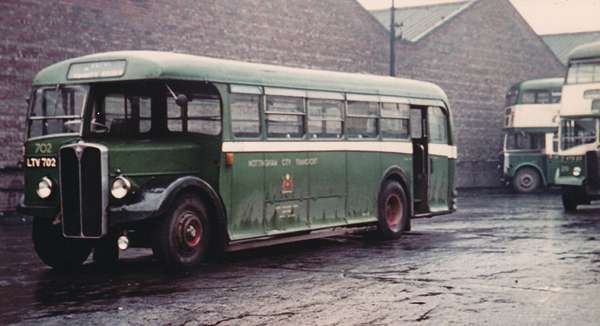
This view shows 702 (LTV 702) at Parliament Street Depot. It is parked on 'MX', the open yard situated between Number Two Depot (the former Trent Garage acquired by NCT circa 1931 when Trent had a new and larger garage built further along Manvers Street) and the Trent Garage, the gable ends of which can be seen in the background behind 702. Latterly the only service that required single deckers was the 8, which ran between Sneinton Boulevard and Trent Bridge via Meadow Lane. It was on Meadow Lane that the reason for the single deck requirement could be found - a low railway bridge of around 11 foot headroom on the Nottingham to Melton Mowbray line. By the mid 1960s the 8 was operated on a part day basis Monday to Friday, with a daytime operation on Sundays during the summer. The winter Sunday and Saturday service had by this time succumbed. Only one bus was required and this was probably the reason why 700 (LTV 700) was sold to Chester City Transport in 1962. Numbers 701 to 703 soldiered on until 1969, when all were withdrawn. One - 702 - is still extant in an unrestored state in preservation.
Michael Elliott
11/04/13 - 16:18
Nice picture Michael. Am I not right in thinking that Hempshill Lane in Bulwell also dictated the need for a single decker on the (again limited) service 35 between Bulwell Market and Northern Cemetery? I think the only occasion I ever travelled on one was a red-letter Saturday afternoon about 1953 when one turned up at the Nuthall Road/Bar Lane stop heading for Hanley Street as a no.7.
Stephen Ford
11/04/13 - 17:35
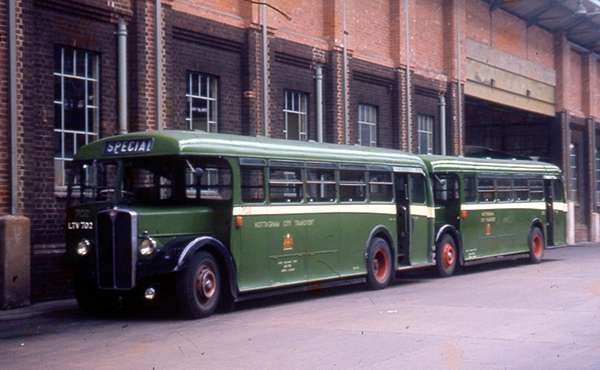
Michael Elliott posted a pic of one of the elegant little NCT Regals,
standing outside in the rain, and here are TWO of them, tucked up warm
and dry in the roofed-over part of Stanhope St. I can`t be more specific
of the date other than mid/late 60s, but around this time, they were
given a last overhaul and repaint, of which the rear one here can be
seen to have been done. As well as having the fleetname on two lines, it
has lost the rear corner bumpers.
Glad there was no attempt to inflict a version of the “1962” livery on
these handsome little fellows.
I remember during my time at Mundella school (near Trent Bridge) that a
lot of my fellow pupils travelled from the Sneinton Dale area and used
the No8, which got duplicated at the appropriate school peak times, so
it was regularly possible to see two together, apart from instances like
the one I caught on camera. No doubt the run-down and eventual closure
of Mundella reduced the need for these vehicles. I suspect the use of
one of these on the Bulwell/Northern Cemetery route was as much for
economy of capacity than the need to be so low, but I also recall one
being used on a short-lived similar trip from Old Market Square to the
General Hospital, saving a walk uphill! I think that one had fares
collected before departure, then ran driver-only for its little journey.
One of my good school friends at the time, who lived off Sneinton Dale,
while not being particularly a bus enthusiast, did express some sort of
affection for these Regals and the Regent 3s used on the Sneinton Dale
to Town routes. I think it was the general comfort of the
AEC/preselector experience, plus the squashy seats, and the tendency for
a tiny screw (or something) to find its way into the horizontal
grabrails and then tinkle-tinkle about on sharp braking or fast
cornering.
Funny how you remember things like that!
Rob Hancock
11/04/13 - 18:25
I too remember the short route to the General Hospital - I think it was allocated route no.50, which was otherwise vacant at the time - the 1960s? Interestingly however, I have seen a published photo showing the Old Market Square in 1948, with one of the older 1937 Cravens bodied Regals (DAU 455, which was successively 76, 276 and 776), displaying "32 General Hospital".
Stephen Ford
12/04/13 - 07:29
Rob/Stephen
Yes, the low bridge (on the Basford Junction to Bennerley Junction via
Watnall and Kimberley line) on Hempshill Lane also required single deck
buses on the 35 (a replacement for the pre-war 23 that was discontinued
in September 1939 'for the duration') that ran at weekends between
Bulwell Market and the Northern Cemetery. This railway line was an early
casualty and the bridge over Hempshill Lane was demolished in 1955 thus
allowing double deck operation from 17/12/55.
There were two attempts to serve the General Hospital before the 'free
service 77' in 1972/3. The first was the 32 that ran from the Old Market
Square to the Hospital via Park Row from 30/08/48 until 17/03/53. From
15/10/51 the 32 was operated by a driver only with fares being collected
before the journey began (there were no intermediate stops)Photographic
evidence shows both the Craven Regals and the LTVs on this service. The
second attempt was the more ambitious 50. The 50 was in operation from
01/02/60 until 06/05/61. It operated from Broadmarsh bus station via
Canal Street, Lower Parliament Street, Huntingdon Street (presumably
using the bus station), King Edward Street, Upper Parliament Street,
King Street, Long Row, Beastmarket Hill, Chapel Bar and Park Row to the
Ropewalk. Again photographic evidence shows LTVs on this service along
with the evidence of my own eyes when ten or so years old of an LTV on
the 50 standing in Broadmarsh. There was also a working, so I'm told, on
the 63 during the evenings during the late 1950s that utilised an
LTV.
Michael Elliott
16/04/13 - 09:20
Two more from my Nottingham Area collection
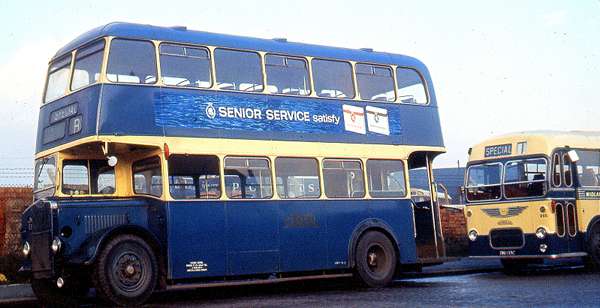
Firstly, again at Nottm Cattle Market, a layover between out and back football special trips from the Erewash Valley, rebuilt ex-utility Guy Arab 347, with the front of MW 265(?) behind. It may be a quirk of the light, but it looks like the front nearside window of the lower deck of the Guy is missing?
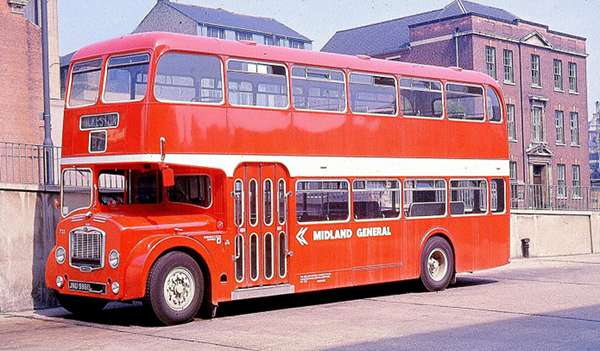
Secondly, a shock-horror moment for me when I came across this FLF in the then new Mount Street bus station in NBC red, the first Midland General vehicle I had seen so painted, (723, JNU 986D).
No more blue, then? The world didn't end, no-one died, but it was never the same again, eh??
Rob Hancock
26/04/13 - 13:17
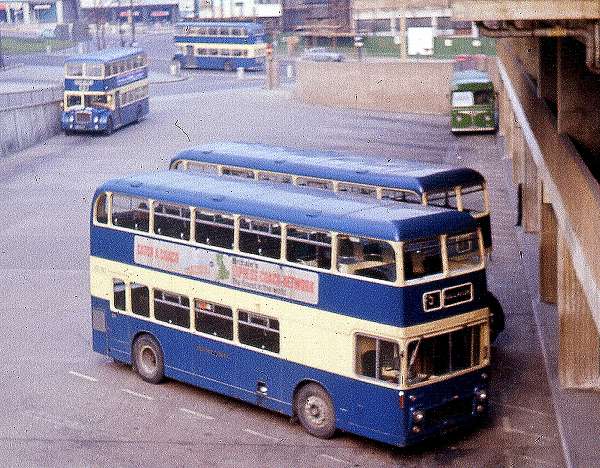
In the same location as the Red Lodekka and at about the same time, but before the red invasion, the short-lived "New" Mount Street bus station, with one of the early flat-screen VRs and selection of Lodekkas. The green single decker was ex-North Western and in use as a staff catering facility.
Rob Hancock
28/04/13 - 09:53
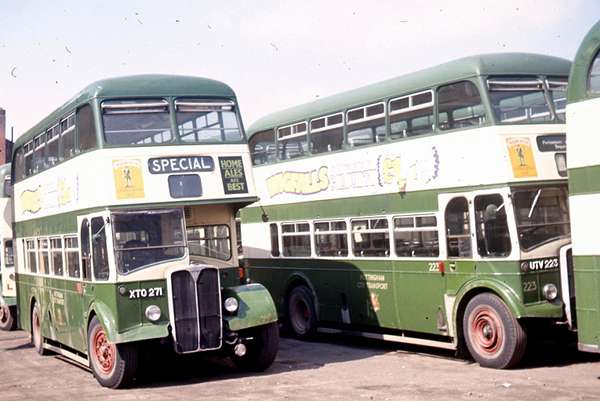
Pennyfoot St yard, late 60s/early 70s, here is Regent5 271 displaying a
non-standard front offside corner. One suspects it had had some accident
damage but the repair does not restore it to original state, as compared
to the example alongside. Lopsided mudguards, to accommodate the droopy
front corner of the dash panel, and no beading to contain the pre-1962
livery cream band.
Anyone know the back-story here?
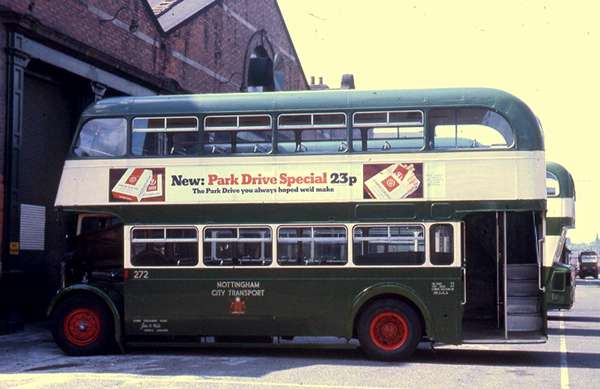
As like 271 above 273 also had individual features, and this second pic is “standard” sister 272, here spotlessly ex-works outside Trent Bridge works. Nice machines, and to me the final incarnation of the traditional Nottingham Corporation bus.
Rob Hancock
29/05/13 - 09:14
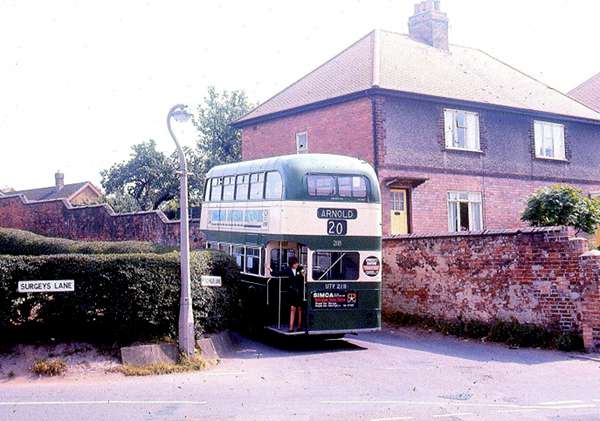
Here is the shot mentioned in my Trolleys Gallery, included partly in
response to a comment posted there 19.5.13 by another Robert.
This is the 20 terminus, and shows a lady conductor assisting her driver
with the reversing move at the 20 terminus.
This was the last day of crew-operation on the Arnold routes, one of
lots of shots I got that day, a veritable Regent V fest!
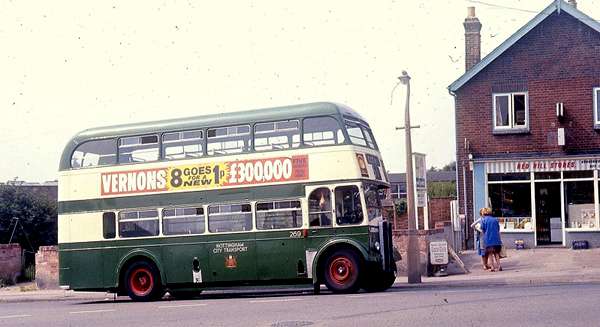
The second shot is the same day, here at the 57 terminus.
Rob Hancock
16/02/14 - 09:38
Regarding the posting by Michael Elliot of Roberts-bodied Regent III 337 in
the interim version of the 1962 livery dated above 26/03/13 - 07:20.
David Allen of Booklaw publications recently showed me an album of
photos that he had recently re-discovered and I instantly recognised
this one as one of his.
That is where the copyright lies.
Rob Hancock
23/02/15 - 07:39
I was very interested to learn that Nottingham 702 (LTV 702) is still in existence. Does anyone know who has it please? In the later 1950s I wrote a letter to NCT to the effect that the service 2 did not need to be double-deck operated on Sundays, and that this could provide the 4 single deckers with extra usage. Surprisingly, perhaps, my suggestion was taken up and 700 to 703 covered the Sunday workings for a few years. My earlier memories were travelling to school from Aspley on a morning duplicate, which was almost always a pre-war single decker from the 776/8/9 series but occasionally a Guy double decker. My favourite buses were, as I have already said elsewhere, Regents 301 to 341, and the very rare pre-war 269 (AMV 462)
Harold Blythe
24/02/15 - 06:03
I remember as student at Nottingham University in the period 1969-1975 that the student union had a single decker bus which looked very much like the AEC Regal and was given the nickname "Rupert". It was used to transport football and rugby teams around, etc. Could this be # 702 or one of its sisters? My home town (Eastbourne) had one, # 11 (now preserved), also with East Lancs bodywork. Very smart machines..
Geoff Welch
24/02/15 - 14:15
I received confirmation yesterday that 702 was indeed the bus that went to the University after its service with NCT ended. It is under active preservation, I understand.
Harold Blythe
27/03/16 - 10:54
KTV 301 ex Nottingham. I am certain that either this or another one of the 41 became the basis of a tar spreading vehicle. I seem to remember seeing it outside Holborn Viaduct station in the early 1970's.
Bill Davies
20/10/16 - 16:11
LTV 702 was used by Nottingham University Students Union until around 1971ish
when my father purchased it and turned it into a mobile home. It
retained the name 'Rupert'.
It was subsequently used for family holidays including a six-week trip
to Greece in 1973, during which I recall (I was only 10 at the time) the
only issues were a broken fan belt in Salzburg, overheating on the
Grossglockner pass and a puncture somewhere in Yugoslavia.
After the Greece trip it was returned to a passenger-carrying vehicle
and used as a school bus (my father was a teacher) in Birkenhead until
1975 when it suffered a terminal breakdown on a school rugby trip
somewhere in the North-East and was scrapped, although, it would appear,
not completely.
It would be nice to see it restored one day.
Pete Broadbere
27/11/20 - 06:35
I remember as a student at the University of Nottingham in the early 70's that one of the 4 AEC Regals was purchased by the student's union, renamed "Rupert" and used to carry sports teams to away matches. Don't know which one. Anybody else recall this or got a photo of him? Hope he survived.
Geoff
03/12/20 - 08:55
I rescued this bus when on the Student’s Union Executive at Nottingham Uni in 1968 having tendered the winning bid when it was taken from service. I gather your Dad drove it to Greese? Any info would be much appreciated.
Peter Jones
06/12/20 - 07:36
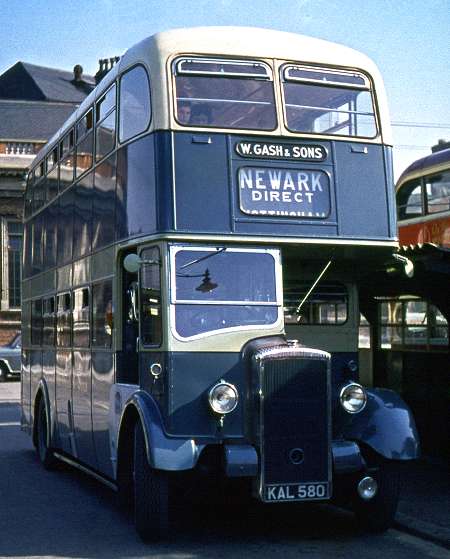
No discussion of Nottingham area buses would be complete without W Gash & Sons. Here is Daimler CVD6 KAL 580, No. DD3, a 1949 chassis. This was delivered originally with a Strachans L27/28R body which was replaced in 1958 by one by Massey of H33/28RD configuration. The picture was taken in August 1961, and the bus was withdrawn in 1979.
Roger Cox
Comments regarding the above are more than welcome please get in touch via the 'Contact Page' or by email at
All rights to the design and layout of this website are reserved Old Bus Photos does not set or use Cookies but Google Analytics will set four see this
Old Bus Photos from Saturday 25th April 2009 to Saturday 26th March 2022